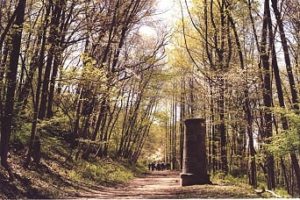
You might not realize it, but the trail that slices through many of these river towns sits atop a rich vein of history. Just below the surface lies the Old Croton Aqueduct, one of the engineering marvels of the 19th century. It’s no exaggeration to say that New York City’s explosive growth would have been impossible without this gravity-fed tunnel, completed in 1842. Before the Aqueduct, water in the city was so scarce and foul that cholera raged, fires burned unchecked, and the safest quaff was beer. All that changed when fresh water started flowing through a 41-mile brick-lined masonry tunnel from the Croton Dam to a reservoir on 42d Street (now the site of the main city library).
The Aqueduct was expected to meet the city’s needs for a century, but in less than half that, the thirsty, rapidly growing metropolis required more water, and three more aqueducts were built — the New Croton in 1890, the Catskill in 1916, and the Delaware in 1945. Water stopped flowing through the original tunnel in 1955, but the northern section was reopened in 1987 and continues to provide water to Ossining.
For the past half century, various groups have worked to protect the trail that sits atop the Aqueduct — now both a State Historic Park and a National Historic Landmark — from those who wanted to drive on it, pave it, or build too close to it. The mission of the current group, the Friends of the Old Croton Aqueduct, formed in 1990, includes the 15-mile New York City leg as well as the 26-mile Westchester section.
Five or six “keeper’s houses” were spaced along the trail, home to the families of the men tasked with working with the engineers to monitor the whole system, as well as watching for signs of trouble, like cracks or leaks. Just two (or possibly three) of these still exist, but the house in Dobbs Ferry is the only one on its original site. It sat derelict for years, but in 2002, the Friends received a federal grant to kick-start a restoration, later supplemented by state money, and raised the required matching funds from private donors. The first work — like replacing boarded-up windows and restoring the badly deteriorated front porch — was done by Friends volunteers.
In June 2016, the work finally complete, the Keeper’s House opened as a visitor and education center, with permanent and rotating exhibits, a video installation, historic photographs, and hands-on displays that appeal to younger visitors, like a ball that rolls through a tunnel to make vivid the power of gravity.
On the group’s web site, aqueduct.org, you can get information about numerous walks and tours, join the Friends, contribute to ongoing efforts to protect and preserve the trail and buy T-shirts, hats, and informative trail maps. All this is also available at the visitor center (now open from 1 to 4 on weekends; that may be extended in the spring).
Watch this space for more news about Aqueduct happenings.







